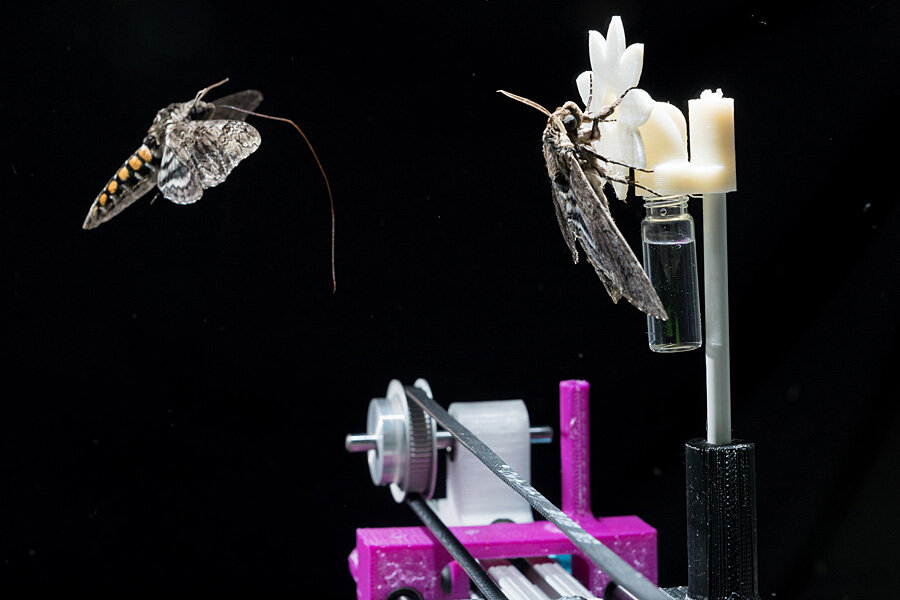Are moths smarter than we think?
Loading...
With its ability to dart, dodge, and hover – all in near darkness – the hawkmoth has recently attracted attention from biologists and Air Force brass alike.
Now, scientists say that they have unlocked the mystery of how Manduca sexta, a large moth native to most parts of North America, is able to lock onto its targets with such precision.
Hawkmoths feed by hovering, hummingbird-like, near a flower in order to reach the nectar. The moth has to continuously calculate for the changing breeze and the varying light conditions, both of which make the process of getting nectar out of the flower more difficult.
“Between midday to midnight [light] changes by 10 billion fold which is one of the most variable quantities in the natural world that animals have to deal with,” says Simon Sponberg, the lead author of this study and an assistant professor at Georgia Tech University.
In an article published in the journal Science, Dr. Sponberg and his colleagues explain that moths adapt to such extreme variations of light by changing the speed of the visual processing parts of their brains.
Sponberg likens the moth's visual perception to a camera. "You’re exposing the visual system to light for a longer period of time before they need to act on the information," he says. "You have many frames being taken sequentially and the frames get exposed to light for a longer period of time, but if you expose them to light for too long the frames get blurred together."
That's why slowing down one's visual processing carries a cost: go too slow, and you're no longer able to track movement. "We found that the moths are doing this, but they’re only doing it to a point and that point is very special. They’re only slowing down their brain to the point where they are able to track the movements of natural flowers. and so they seem to be tuned to the demands of their natural environment.”
To explore the range of visual speeds available to the moth, researchers used robotic flowers whose oscillation could be tuned. The frequencies at which the moths were most adept at tracking the flower in adverse lighting conditions were below 2Hz. After studying the movements of the natural flowers in the wind, the scientists found that 94 percent of the motions they made were at frequencies below 1.7 Hz.
“It actually performs quite poorly at flower movements that are very high but as it turns out, it actually doesn’t matter that it performs poorly because the real movements of flowers in the wild are actually quite slow. I think that’s an important point is that during the process of evolution there are these magnificent solutions that evolve which match the sensory and the muscular ability of animals, the very specific tasks that they need to solve in their world,” says Eric Warrant, a professor at Lund University in Sweden and an expert in the field of animal vision.
“What I think is particularly noticeable there is that we have great engineering that can do a lot of specific tasks but you usually think of a task and then design a system for that task, whereas biological systems can do many things with the same components,” says Sponberg.
Scientists aren’t the only ones intrigued. The Air Force has been diligently studying moths at the Air Force Center of Excellence on Nature-Inspired Flight Technologies and Ideas in order to understand how they are able to make such rapid flight movements.
‘If we want to have robots or machine vision systems that are working under this broad range of conditions, understanding how these moths function under these varying light conditions would be very useful.’ said Dr. Sponberg in a press release.
The research is just one of many projects that seek to find engineering solutions in the natural world. “I think that one of our biggest problems as humans is that we tend to complicate things unnecessarily. The beauty of evolution is that during the process of evolution, complication has been removed because complicated solutions tend to be bad ones,” says Dr. Warrant.
Sponberg is cautious to claim the presence of a co-evolutionary relationship between the hawkmoth and the flowers it feeds on, such as those between some species of flower and hummingbird. In Sponberg's experiment, the moths used had not tracked flowers before, “so it seems like they do have some inherent innate preference for the types of flower movements that the robot flower could generate and the natural flowers do generate.”
“What’s possible next is to understand the mechanistic basis for this slowing down and how nervous systems make this change,” says Sponberg.
“Sometimes I wonder if the best question is to say how does the brain work? Maybe a better question is to say given how the animal behaves, about its physics, about its environment, how must the brain work in order to enable these great behaviors that we see out there, and be able to translate that perhaps into our engineering systems,” says Sponberg.








